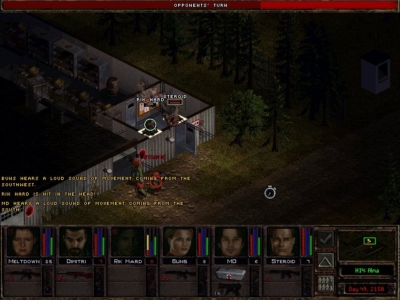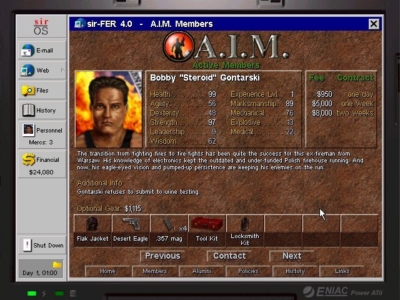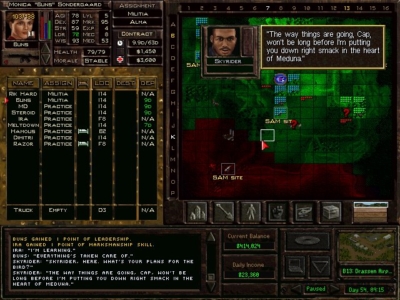
Jagged Alliance 2
Written by: Rik
Date posted: April 3, 2007
- Genre: Strategy
- Developed by: Sir-Tech
- Published by: TalonSoft
- Year released: 1999
- Our score: 7
Regular visitors to FFG will know that while we are, of course, both expert gamers (stop laughing at the back there), we nevertheless each have our strong points and weaknesses, which are reflected in the number of entries we have in each section. Stoo, for example, tends to run screaming from most sports games, and though he does play the occasional racer, it’s usually to see what happens when you turn the car around and drive the wrong way round the track. On the other side of the coin, I wouldn’t know what an RPG looked like if the game CD was rammed into my eye sockets, and at the time of writing, my solitary contribution to the strategy section is a review of Red Alert, a game I didn’t manage to finish even with a magazine walkthrough resting on my lap.
Still, here I am, and with a turn-based strategy game no less. For those of you who don’t remember, the original Jagged Alliance was a solid if fairly unremarkable title, released to moderate acclaim in the mid-90s. The main thing I can recall about the game is my own ineptitude in being unable to complete a short demo version from a magazine cover disc (par for the course as far as me and this type of game are concerned) and though it was mildly impressive at the time, it certainly didn’t strike me as the sort of game that would have millions of fans clamouring for more. In the event, while it was never as well regarded as the likes of UFO, Jagged Alliance did attract a sizable enough following for the developers to crank out a mission disk, Deadly Games, as well as a sequel, which is the game we’re concerned with here.

If there’s no combat to be had, you can just wander around heroically looting houses for money and goodies.
The plot concerns the fictional island of Arulco, which is suffering at the hands of an evil dictator, Queen Deidranna. Arulco’s former leader, Enrico Chivaldori, has entrusted you with a whacking great load of cash with which to hire a group of mercenaries and take back the island. Frankly, it’s not the most original story in the world – in fact, it’s pretty much identical to the setting of the first game, albeit without the bizarre tree-sap-as-medicine sub-plot. Once you’ve recruited your mercenaries, it’s straight into the first sector, and though there are some other elements to the game, it has to be said that the action in Jagged Alliance 2 largely consists of travelling from town to town gunning down hundreds of local troops along the way.
The game uses a nifty combat system which allows you to roam freely in real-time until you ‘engage’ the enemy, at which point you switch to a turn-based system, where each moves costs ‘action points’ and you generally start having to think more carefully about things. All-in-all, it works pretty well, and though there are plenty of commands and options available, once you’ve got the hang of all the various keyboard shortcuts everything soon becomes second-nature. It’s a good job too, because Jagged Alliance 2 is pretty tough, and even on the easier settings you can’t really get away with blundering about in full view of the enemy without being punished. Early skirmishes can be quite frustrating, not only because the computer is pretty ruthless, but also because your mercenaries generally don’t have very good weapons, with the various guns and pistols at your disposal having frustratingly short ranges. Eventually, you get your hands on better ones, but you usually have to prise them from the cold dead fingers of your enemies’ corpses, which obviously means there are some tough battles to get through first.
Generally (and I’m saying this as quite a positive thing), it seems that the computer is always one step ahead of you, with each new sector you enter presenting new challenges in one form or another. Though progress initially seems almost impossible, it’s usually just a matter of trying out new tactics and generally getting better at the game. There are the occasional frustrations, such as the time-honoured problem of a bad guy hiding in a room waiting for you to open the door so he can blow your head off, but on the whole, the combat in JA2 is handled nicely.
Your progress through the island is monitored via the map screen, which indicates which sectors you’ve taken, where you have militia posted, how much money you have, and so on. From this screen, you can direct your mercenaries to rest, go to another sector, or even practice some of their skills. In terms of the amount of management you have to do in-between skirmishes, it’s nothing like as detailed as in something like UFO, but there are a few things that you have to keep an eye on. For example, the initial lump sum you get from Enrico isn’t going to pay your mercenaries’ wages forever, so you need a more sustainable source of income, which comes in the form of the mines, found in a number of towns on the island. Also, once you’ve gained control of an area, you need to train up a local militia to protect the town against attack – Deidranna’s forces are constantly roaming the island, and frequently try to take back some of the sectors you’ve conquered. The map screen also allows you to use your laptop, which you can use to go to any one of a number of useful websites, allowing you to order more weapons and equipment, or hire more mercenaries if required.
When not engaged in combat, your mercs are free to wander around the town and occasionally engage in conversation with the locals. Sometimes it’s just a matter of passing the time of day or getting a little bit of background information on the town or the island’s history, but most of the time, they’ll give you some kind of task to perform. Some are compulsory and plot-specific, while completion of other, optional, quests may see you rewarded with some extra weapons, the use of a vehicle, or even someone offering to join your team. To be honest, this part of the game isn’t so well done, with your conversation options limited to adopting a ‘friendly’, ‘direct’ or ‘threatening’ approach. On top of that, certain stats of the merc you happen to be using are taken into account, so if you happen to be employing a particularly charmless bunch, you could miss out on quests, or even end up in a gunfight with certain NPCs as a result. While this may be considered pretty standard fare for a role-playing game, you can’t help but feel that this could have been handled a little better, and there are times when you wish you didn’t have to bother speaking to the NPCs at all.
Another RPG influence concerns the mercenaries themselves. All of the mercs you can recruit have a number of statistics which affect how well they can perform certain actions in the game. With experience and practice, these skills can improve over time, and though you may have to recruit fairly cheap mercenaries at the beginning, once they’ve been with you for a while their stats have usually improved markedly. On top of that, you get to create your own ‘custom’ mercenary by answering a few multiple-choice questions and then fiddling with a few statistics bars according to your own preferences. It’s all done in quite a fun way, and given the absence of any magic, dragons or beards, and the combat-heavy content of the game, it basically boils down to what kind of American macho-jock you want to be. The choice of picture and voice for your custom merc is fairly arbitrary since they’re all muscle-bound, unshaven types with quite gravelly voices who like nothing better than spouting clichés a-plenty while in the thick of the action. Still, the way you answer the questions does dictate what special skills your merc will have, and there’s no doubting that the distribution of points on the statistics screen will have an effect during the game, so it’s definitely worth paying some attention to.
Though your own alter-ego may be a bland Seagal-alike, the various mercenaries for hire are quite an interesting bunch, each with their own personalities and histories. A nice touch is that they all have their own, quite distinctive, scripts and set phrases, and looking back, this was one distinguishing feature that won the original Jagged Alliance so many fans – well, those who had the CD version, at least. Though some of the voice acting is a little patchy (see More Evil Peoples!, for more), the different personalities of the mercenaries do come across really well. Sad as it may sound, you can also become quite attached to some, if not all, of your party, and after a bit of time you can find yourself going to quite extraordinary lengths to make sure none of them die during battle, even though you could easily hire a replacement if necessary. It may seem like a little thing, but after years of sending personality-free drones to their death in various RTS games, I actually found this quite refreshing.

After a while, you’ll try and conduct most of your combat missions at night – there’s a lot of sneaking around, but it usually pays off.
The sound, then, gets a hearty thumbs-up, with the huge amount of speech complemented by some decent sounds effects and some fairly inoffensive music. Graphically, Jagged Alliance 2 is functional rather than spectacular, and it’s a good job that your mercenaries are all distinguished by their voices because it’s very difficult to tell them apart on-screen, with everyone seemingly opting for the same muscle-vest/combat trousers combo. While the isometric view works well for the most part, you can occasionally come unstuck if you venture indoors, with scenery cluttering your view and the interface suddenly feeling quite fiddly. Still, the resolution is fairly crisp, the animations are smooth enough, and it all looks perfectly presentable.
So much for describing the game’s features – clearly, there’s plenty to do in Jagged Alliance 2, but how well does it all hang together? Well, as we’ve already mentioned, while the combat sections are pretty good fun, some of the RPG bits are less so. Conversations with NPCs and story-based quests should come as a welcome distraction from the relentless turn-based combat, but instead they’re an irritating chore that you’d rather not bother with if at all possible. There’s obviously a lot more to do in the game if you talk to everyone, take every quest and explore every building in every sector, but personally, I found myself wanting to just move on after taking control of a town rather than chatting to the locals. For one thing, the story just isn’t that interesting – and the terrible script and awful voice acting certainly don’t help matters either. On top of that, the interface seems to be designed for combat rather than talking and exploring, and the whole business can seem pretty irritating and cumbersome.
Beyond this, it’s difficult to pinpoint too many other major flaws – although the original release featured a number of quite annoying bugs, some of which don’t seem to rear their head until you’ve progressed a fair way through the game, so I’d advise trying to get hold of all the available patches before starting. Another piece of advice – make sure you play the game on ‘Realistic’ rather than the ‘Sci-fi’ setting if you want to avoid some preposterous plot twists and a few more hours of combat.
Overall, though, Jagged Alliance 2 is a tricky game to evaluate. One the one hand, you can certainly appreciate that a tremendous amount of effort has gone into producing the game. There’s a staggering amount of detail on offer, and you can spend a good while away from the action on your fake laptop browsing through the biographies of all the different mercenaries, or reading a 16-page report profiling the island of Arulco. In game, there are also loads of little sub-quests and features that reward the more curious gamer, and when you take into consideration how the personalities of your mercenaries really come across, there’s certainly a case to be made for coming back to the game once you’ve completed it, in order to try different strategies, use different personnel, or even be on the lookout for things you may have missed first time around.

After a while, you’ll try and conduct most of your combat missions at night – there’s a lot of sneaking around, but it usually pays off.
That said, once may be enough for most gamers. Jagged Alliance 2 is a long, tough slog, especially for non-strategy nuts, and though there’s plenty of content in the game, you may find yourself questioning whether it’s worth the effort. Though the low-budget and slightly amateurish feel of the game is in many ways part of its charm, the storyline and script unfortunately leave a lot to be desired, and ultimately fail to represent enough of a reward for progression through increasingly tough rounds of turn-based combat.
Though JA2 may not even qualify as an ‘oldie’ in some people’s eyes, they certainly don’t make ’em like this any more. And more’s the pity, because this was clearly a labour of love for the developers, and while some aspects of the game come across as a little bit cheap and, well, rubbish, on the whole it’s had attention lavished on it to the very last detail. At the end of the day, how much you enjoy the game may depend on how much this impresses you. At its heart, Jagged Alliance 2 is a solid, well-implemented turn-based strategy game. If you happen to have a soft spot for an underdog, like games with detail and depth, and are willing to forgive occasional sloppiness (and bad accents), chances are you might really take to it. And me? Well, with only half the island conquered after eight years of dabbling, I’ve decided to call it quits. I’ll see you back in this section some time in 2015.



 Posts
Posts